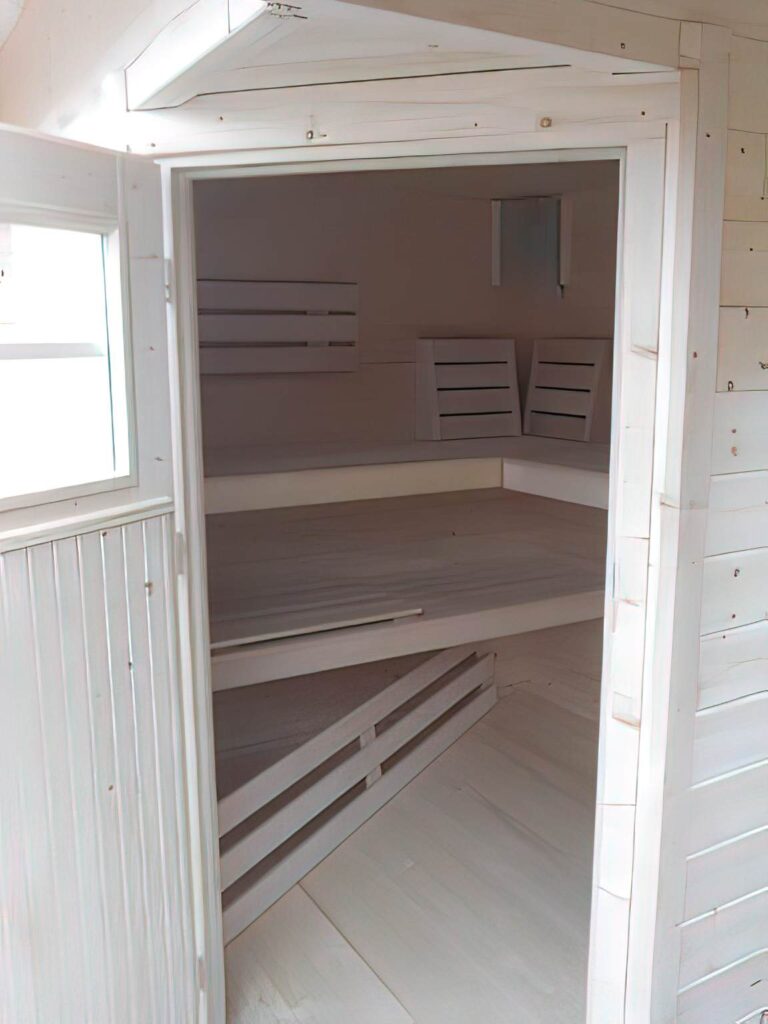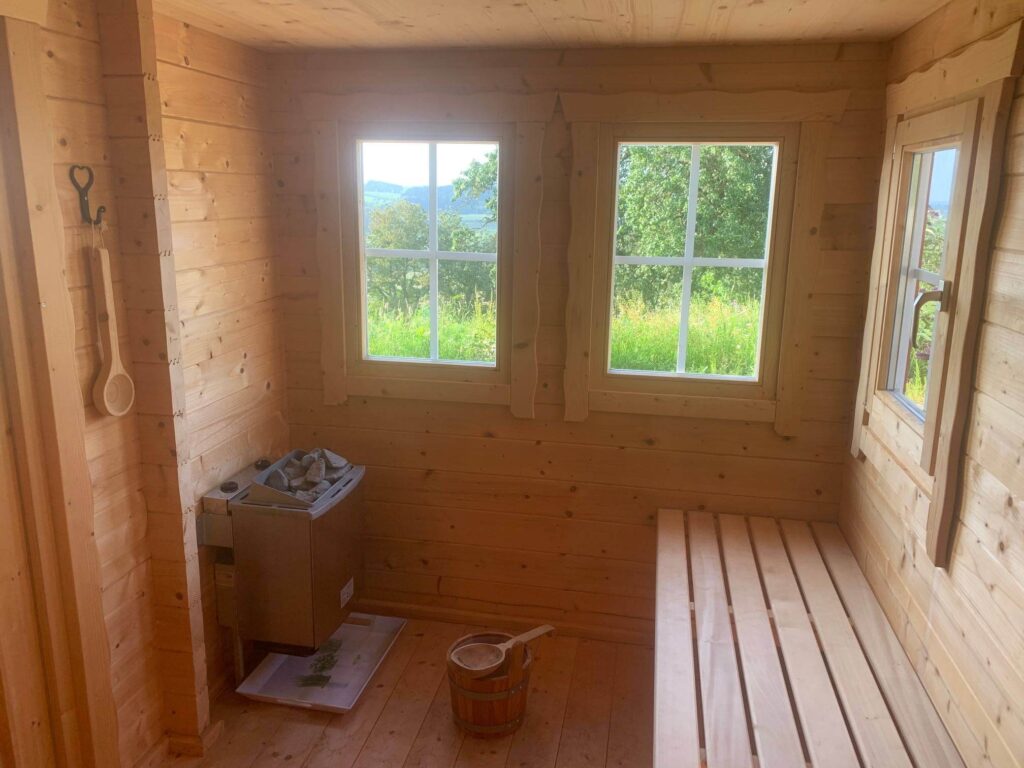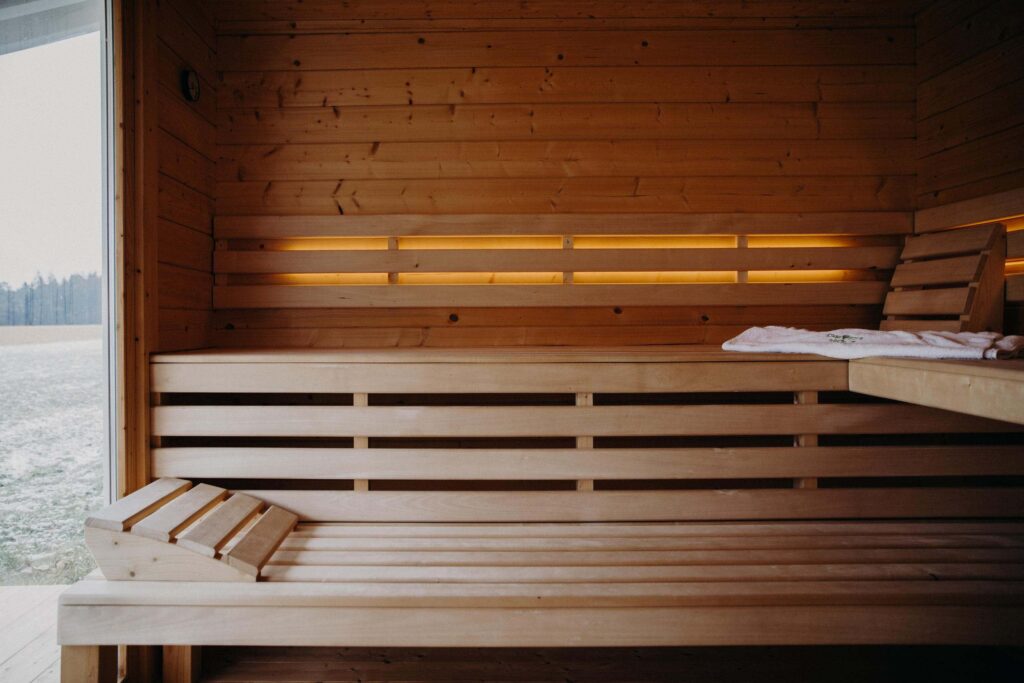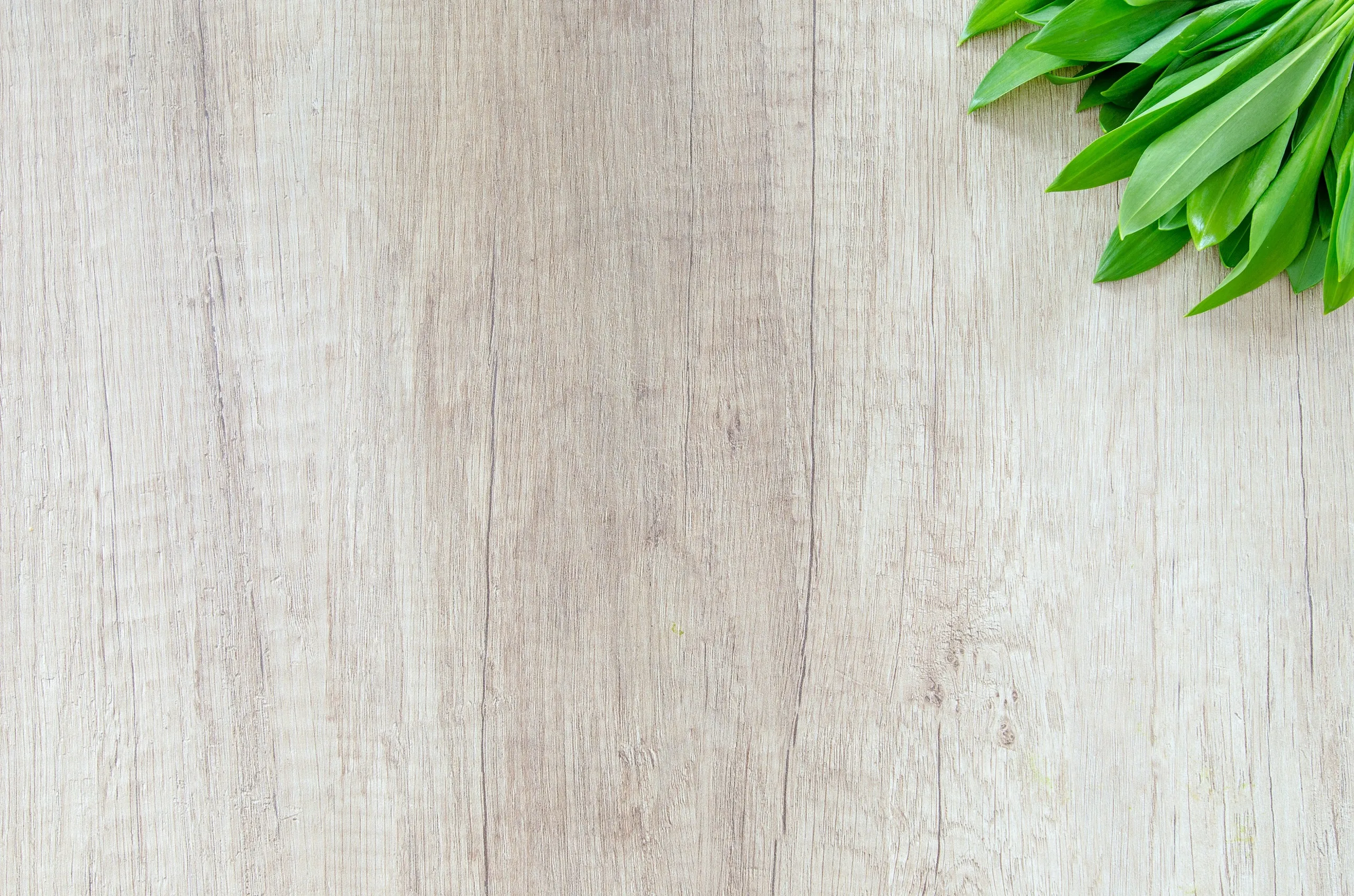
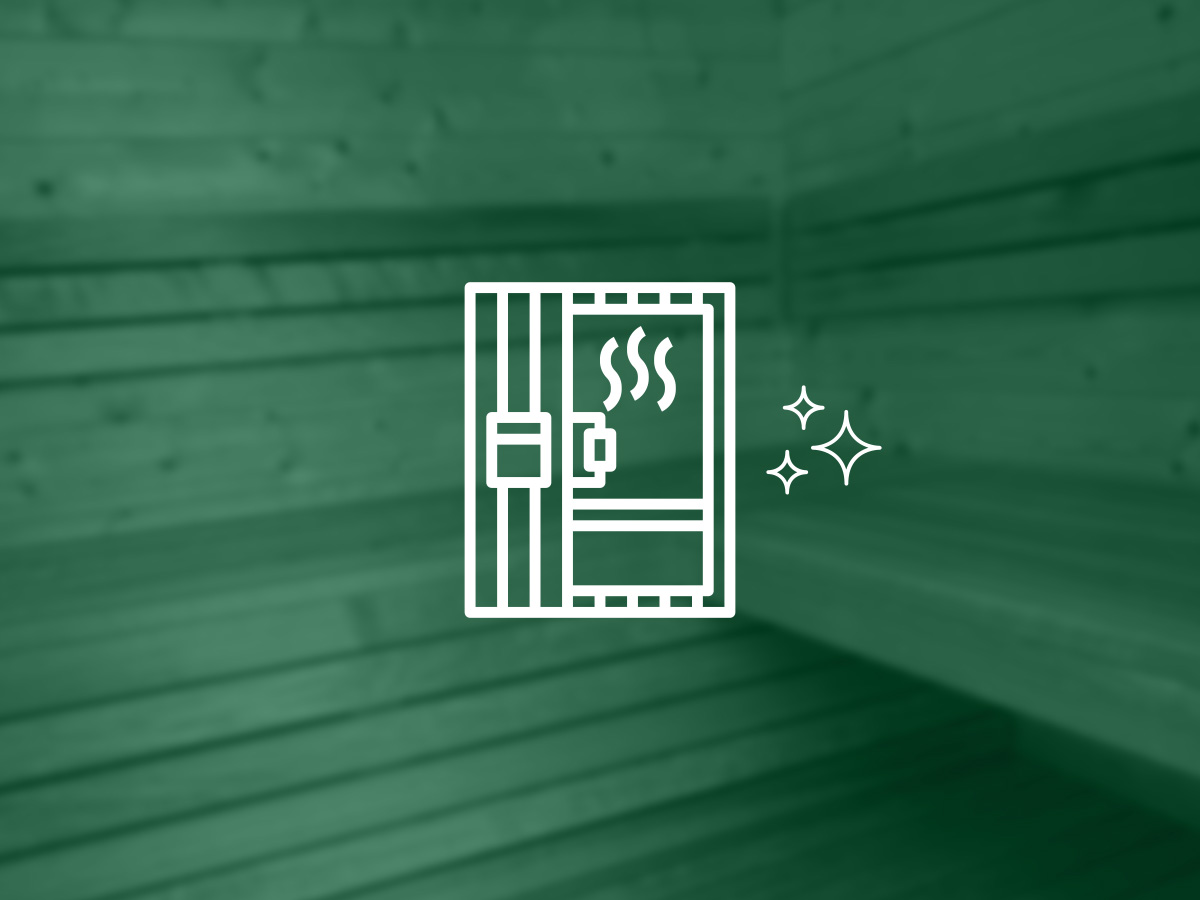
How to clean a sauna? Home methods and practical tips
The sauna is a place for relaxation and regeneration, but in order for it to serve us for many years, it requires regular care. High temperatures and humidity can encourage the growth of bacteria and the formation of deposits, so proper hygiene is key. In this article, you will find practical and proven ways to clean your sauna.
Cleaning the sauna before a session
Before you start sauna bathing, it’s a good idea to take care of basic hygiene to ensure a pleasant and healthy user experience. Regular cleaning before each session helps to prevent the build-up of dirt, bacteria and unpleasant odours, as well as prolonging the life of the wooden components and the cooker.
Here are some key steps to keep in mind before you start your session:
1. Check that the interior of the sauna is dry – moisture can encourage the growth of bacteria, mould and fungi. Before starting the sauna, make sure the interior has been thoroughly ventilated after previous use.It is best to leave the door or ventilation windows open so that air circulation removes excess moisture.
2. Remove dust and small debris – the wooden elements in the sauna should be cleaned regularly of dust and particles that may settle on the benches and walls. A soft, dry cloth or a brush with fine bristles will work well for daily surface cleaning. If you notice greasy sweat stains, it’s a good idea to wipe them down with a slightly dampened cloth with a natural cleaning agent such as a solution of water and vinegar.
3. Take care of the floor – before you start your session, make sure the floor is clean. You can wipe it down with a damp mop to remove particles of sand, dust or fibres that may have accumulated. For an added effect, add a few drops of essential oil – this will give the interior a fresh, pleasant scent that will affect the comfort of the sauna.
4. Check the condition of the stones and cooker – the sauna heating stones should be free of dirt and deposits.Lingering residues of essential oils or minerals from the water can cause unpleasant smells and even lead to smoke during reheating. If you notice any dirt, it is a good idea to rinse it gently with water or wipe it off with a slightly damp cloth. For heavier deposits, a bath in a solution of water and vinegar can be used.
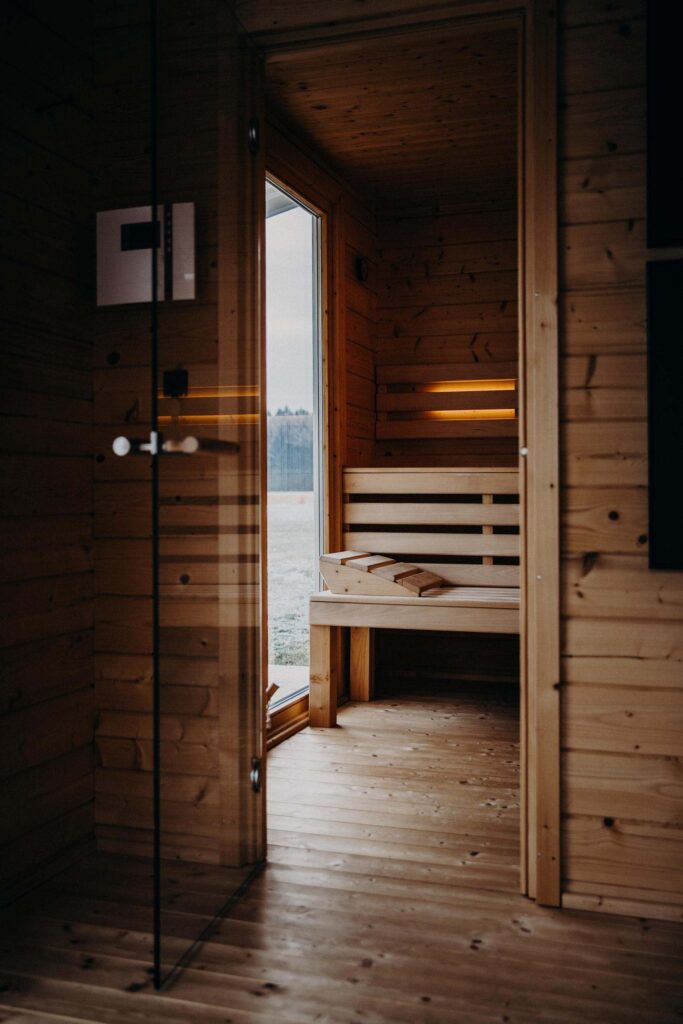
Keeping the sauna clean after the session
Regular cleaning of the sauna after each session is the key to keeping it in excellent condition for years to come. Neglecting to clean can lead to unpleasant odours, discoloured wood and even mould growth.
Key steps to keeping your sauna clean after a bath:
1.Ventilate the sauna thoroughly – after bathing, the sauna remains humid and heated, to prevent excessive vapour build-up on the walls and ceiling, leave the door and ventilation windows open for at least 30-60 minutes to allow the air to circulate effectively and allow all moisture to escape.
2. Clean up essential oil residues – if essential oils have been used during a session, it is worth checking that they have not settled on the stones, cooker and/or wood. The oils can leave an oily residue, which can give off an unpleasant smell or even cause smoke when heated again.
3. Cleaning the floor – the sauna floor also needs attention after each session. Depending on the type of floor (wood, tiles, stone), it should be vacuumed or wiped with a damp mop, removing accumulated dust, sand and sweat residue. If the floor is wooden, avoid excessively soaking it to avoid deforming it. To freshen it up, you can add a few drops of eucalyptus or lemon oil, which have antibacterial properties, to the water.
Home remedies for cleaning sauna wood
The wood in the sauna is exposed to heat, moisture and perspiration, which can lead to discolouration, deposits and unpleasant odours. In order to preserve its natural appearance and durability, it is advisable to use gentle but effective cleaning methods that do not damage the structure of the wood. Here are some tried-and-tested home remedies for caring for wooden sauna components.
- Vinegar water – is a natural disinfectant that effectively removes dirt, eliminates bacteria and neutralises unpleasant odours. Simply mix water and vinegar in a 1:1 ratio, soak a cloth and wipe the wood. This will keep the wood clean and fresh, while not leaving chemical residues on the wood as with synthetic cleaners.
- Baking soda – is great for removing stubborn plans, such as those from sweat or grease. To clean a stained surface, simply sprinkle baking soda on the stain, gently dampen it with water and wipe it off with a soft sponge. Baking soda also acts as a natural moisture and odour absorber, which further helps to keep the sauna in good condition.
- Lemon and salt – a combination of lemon juice and sea salt is an effective way to tackle tougher stains, such as dark stains on benches or walls. Lemon has an antibacterial effect and neutralises odours, while salt gently exfoliates stains. Simply sprinkle the stain with salt, add a few drops of lemon juice and wipe the wooden surface with a soft cloth or sponge.
- A paste of potato flour and water – great for removing greasy stains that may appear on benches or backrests. The potato flour absorbs the grease and the fine paste with the addition of water acts as a natural scrub for the wood, removing the dirt without damaging the surface. Apply the paste to the dirt, leave it for a few minutes and then wipe it off with a dry cloth.
To avoid damaging the wood, avoid aggressive detergents that can penetrate the pores of the wood, causing it to dry out and leaving chemical deposits.
How to clean the sauna cooker?
The cooker is the heart of the sauna, so it is advisable to regularly maintain its cleanliness. How to do it?
- Remove accumulated ash and dust – if you have a wood cooker, empty the firebox regularly. For electric cookers, gently vacuum the vents.
- Wash the cooker with a damp cloth – avoid strong chemicals that can damage the protective coating.
- Check the condition of the heating elements – a regular check will prevent malfunctions and keep the sauna at the right temperature.
What to do when the stones are dirty
The sauna stones can become dirty due to the deposition of residual oils, dust and minerals from the water. To clean them:
- rinse them with clean water – this will remove light dirt,
- soak in a solution of vinegar and water – leave for a few hours, then rinse thoroughly,
- avoid cleaning the stones with detergents – chemicals may penetrate into the air during heating, which is not safe for health.
If the stones are badly damaged or cracked, replace them.
Why you should disinfect your sauna?
Regular disinfection of the sauna ensures hygienic conditions and protects against the proliferation of bacteria.This is especially important in areas where the sauna is used by many people. For this you can use:
- natural agents such as vinegar, baking soda or tea tree oil, which has an antibacterial effect;
- specialised sauna products which are safe for wood.
It is worth remembering that disinfection should be carried out at least once a month so that the sauna remains hygienic and user-friendly.
The most common sauna cleaning mistakes and how to avoid them
Regular cleaning of the sauna is crucial for its longevity but also for our comfort. Unfortunately, sometimes our actions, even if unconsciously, can do more harm than good.
- Using aggressive detergents – strong chemicals can damage the structure of the wood, making it more susceptible to drying out, cracking and discolouring. In addition, chemical deposits can seep into the pores of the wood, leading to the release of noxious and unpleasant odours during seating. Instead, it is advisable to use natural cleaners such as vinegar water, baking soda or lemon.
- No ventilation after a session – leave the sauna open for at least 30 minutes after each session. Closing a damp sauna without proper ventilation can lead to mould growth, moisture build-up and unpleasant odours.
- Too infrequent care of the stones and cooker – the stones in the sauna cooker become covered with water deposits, essential oil residues and dust over time, which can reduce their ability to provide effective heat.It is a good idea to clean them regularly, removing accumulated dirt with a soft brush and water and replacing worn stones from time to time to ensure optimum sauna performance.
Tips for sauna care and longevity
In order for your sauna to serve you for many years, you don’t need any special treatments rather regularity and consistency. Here are three key rules to help you keep your sauna in excellent condition.
- Ventilate your sauna regularly – after each session, leave the doors and windows open for at least 30 minutes to allow full air circulation. This will help prevent moisture build-up, which can lead to mould and unpleasant odours. In addition, regular airing helps to keep the wood fresh and preserve its natural properties.
- Clean the wood with gentle products – sauna wood is porous and sensitive to aggressive detergents, which can dry it out, weaken it and cause discolouration. It is best to use natural cleaners such as a solution of water and vinegar, baking soda or lemon, which effectively remove dirt and bacteria without affecting the structure of the wood.
- Look after your cooker and stones – by regularly removing accumulated dust, deposits and residual essential oils from the stones, you can maintain their performance and prolong the life of your cooker. Every few months, it’s a good idea to clean the stones thoroughly with a soft brush and warm water and, if necessary, replace those that are starting to crumble. Regular maintenance of the cooker will ensure that the sauna is heated safely and efficiently, and will avoid problems associated with the build-up of deposits on its heating elements.
Summary
Regular sauna maintenance is the key to sauna longevity and comfortable use. Taking care of the cleanliness of the wood, cooker and stones and avoiding the most common mistakes will ensure hygienic and pleasant conditions for relaxation. It is worth remembering that daily, small preventive measures are much easier and more effective than subsequent thorough cleaning or the need to repair damaged parts.
FAQ section
How do I clean the interior of the sauna?
Wipe down the wooden parts with a damp cloth, avoid aggressive detergents, and disinfect once a month using natural products such as vinegar or baking soda.
How often should the sauna be cleaned?
Basic cleaning should take place after each session, while thorough cleaning and disinfection should take place at least once a month.
How do I look after the sauna cooker?
Regularly remove dust and deposits from the surface of the cooker, and rinse the stones with water to remove residual essential oils and minerals. Check the condition of the heating elements every few months and replace worn stones.
Can chemicals be used to clean the sauna?
Aggressive detergents are not recommended, as they can penetrate the wood and release harmful substances during heating. It is best to use natural cleaning products that are safe for health.
What should I do if the wood in the sauna starts to darken?
Darkening of the wood can be the result of moisture and dirt. You can gently sand the surface with fine sandpaper and then clean it with a solution of water and vinegar to restore a fresh appearance.
